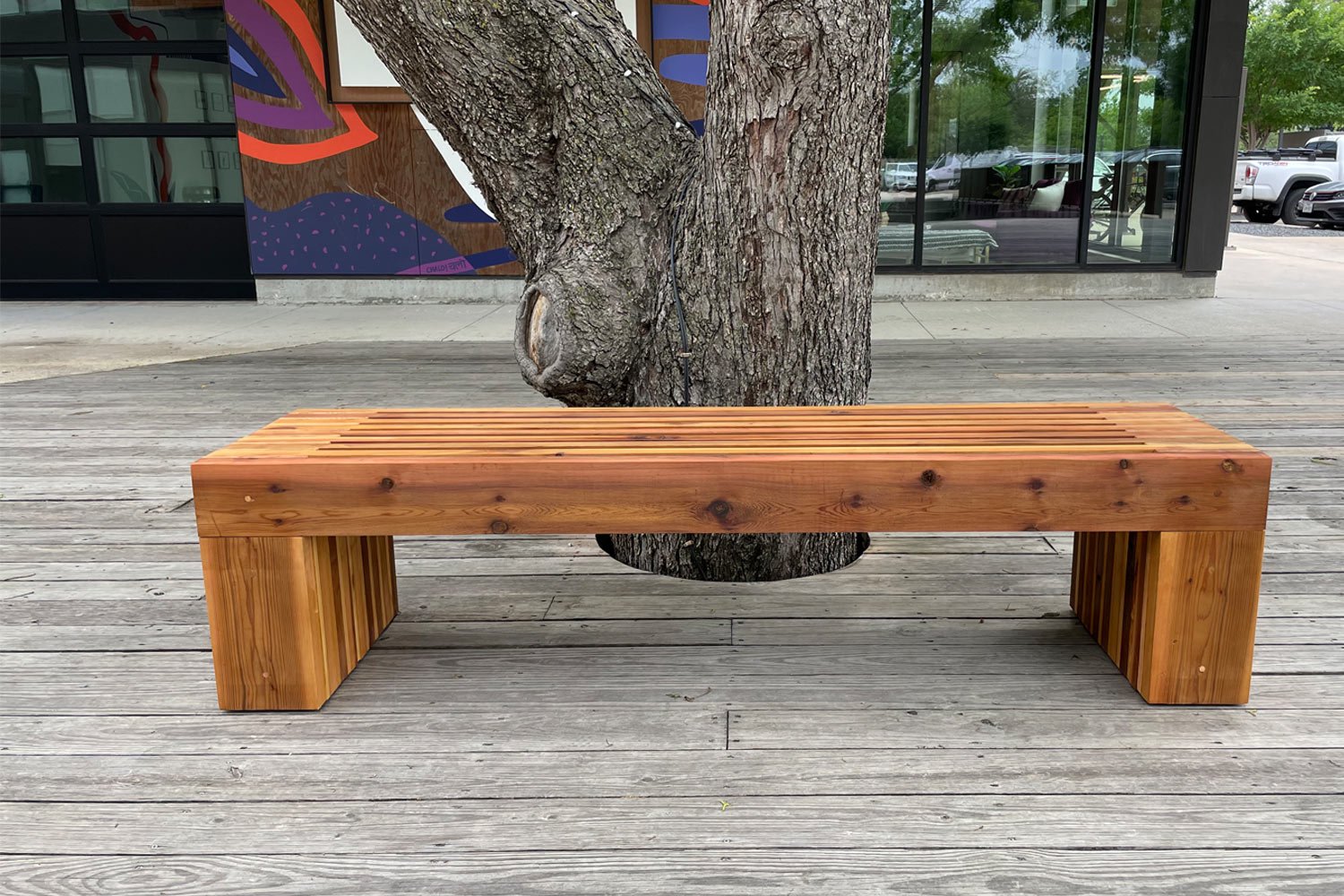
These are the materials we prefer.
Materials Resource Page
Thermally Modified Wood
Thermally Modified Ash, Kebony, and Accoya, offer several benefits in terms of sustainability and performance. Through the thermal modification process, these woods achieve enhanced durability, stability, and resistance to decay without the use of chemicals. This method involves heating the wood to high temperatures in controlled environments, altering its cellular structure to make it less susceptible to moisture absorption and fungal growth. As a result, thermally modified wood products have a longer lifespan than untreated wood, reducing the need for frequent replacement and minimizing environmental impact. Additionally, they often come from sustainably managed forests or are made from fast-growing species, contributing to responsible forestry practices. By choosing thermally modified wood, consumers promote a more environmentally friendly building material that balances durability with ecological stewardship.
PROS
Enhanced Durability: Thermally modified wood resists moisture, decay, and insects due to its altered cellular structure.
Stability: It reduces the wood's tendency to expand and contract with humidity changes, improving dimensional stability.
Chemical-Free: Typically does not use chemicals, making it environmentally friendly.
Aesthetics: Enhances natural color and grain for a richer appearance.
Sustainability: Sourced from sustainably managed forests or fast-growing species, promoting sustainable forestry practices.
CONS
Cost: Generally more expensive due to specialized manufacturing.
Limited Availability: May not be widely available, limiting choices based on location and suppliers.
Performance Variability: Effectiveness can vary based on wood species and manufacturing quality, leading to inconsistencies.
Impact on Workability: Can be brittle and harder to work with, requiring specialized tools and techniques.
Longevity of Color: Initial color enhancement may fade over time with sunlight and weathering, necessitating maintenance for appearance retention.
Bamboo
Bamboo wood products provide dual advantages in sustainability and performance. Bamboo, a rapidly renewable resource, matures within three to five years for some species, making it an eco-friendly alternative to traditional hardwoods. Its quick growth and regeneration after harvesting alleviate pressure on forests and aid in carbon sequestration. Bamboo's strength-to-weight ratio rivals that of many hardwoods, and its natural resistance to pests and fungi often eliminates the necessity for chemical treatments, bolstering its eco-friendly profile. Opting for bamboo supports sustainable agriculture and reduces dependency on finite timber resources.
PROS
Rapid Renewability: Bamboo matures in 3-5 years, much faster than traditional hardwoods.
Environmental Sustainability: Bamboo forests absorb more CO2 and encourage rapid regrowth, reducing pressure on natural forests.
Strength and Durability: Bamboo is strong and durable, suitable for various applications.
Versatility: Bamboo can be used in flooring, furniture, textiles, and more.
Natural Resistance: Bamboo has natural antimicrobial properties, reducing the need for chemical treatments.
CONS
Processing Challenges: Bamboo requires specialized processing and may involve energy-intensive methods.
Quality Variability: Product quality can vary based on species, age, and processing.
Environmental Concerns: Harvesting practices and intensive farming can impact ecosystems.
Transportation and Carbon Footprint: Transporting bamboo from tropical regions can increase its carbon footprint.
Limited Species Diversity: Bamboo offers fewer species options compared to traditional hardwoods.
Domestically Sourced Wood
Domestically sourced wood products like Western Red Cedar, Black Locust, and Eastern Aromatic Cedar offer superior sustainability and performance. These woods are prized for their natural durability and resistance to decay, minimizing the need for chemical treatments and extending their lifespan in outdoor use. Sourced locally, they reduce transportation distances and carbon emissions, thus lowering environmental impact.
Western Red Cedar, renowned for its beauty and stability, originates from sustainably managed Pacific Northwest forests. Black Locust, native to the eastern U.S., is valued for its strength and rot resistance, ideal for outdoor structures. Eastern Aromatic Cedar, found in the southeastern U.S., is known for its aroma and natural insect-repelling properties. Opting for domestically sourced wood supports local economies, promotes responsible forestry, and ensures a sustainable supply chain from forest to finished product.
PROS
Sustainability: Domestically sourced wood reduces transportation distances, carbon emissions, and supports local economies and forestry practices.
Durability: These woods are naturally durable, resistant to decay, insects, and weathering, suitable for outdoor use without chemical treatments.
Aesthetics: Each species offers distinct grain patterns and colors, enhancing the visual appeal of projects like decking, siding, and furniture.
Availability: Typically more accessible in their native regions, ensuring consistent supply and shorter lead times for construction projects.
Renewability: Managed forests in the U.S. and Canada promote sustainable harvesting practices, benefiting long-term forest health.
CONS
Cost: Some domestically sourced woods can be pricier due to higher labor and production costs, especially for specialty grades or sizes.
Regulatory Compliance: Adherence to environmental regulations and certifications may be necessary for sustainable sourcing.
Limited Species Diversity: While Western Red Cedar, Black Locust, and Eastern Aromatic Cedar offer desirable properties, the selection may be narrower compared to diverse imported hardwoods.
Environmental Impact: Despite sustainable practices, harvesting and processing can still impact habitats and soil if not managed carefully.
Maintenance Requirements: Regular upkeep like staining or sealing may be needed, particularly in harsh climates, to maintain longevity and appearance.
Brazilian Hardwoods
FSC-certified Brazilian hardwoods such as Ipe and Cumaru are prized for sustainability and durability. Known for their hardness, density, and resistance to rot, insects, and weathering, they excel in outdoor settings with heavy use. The Forest Stewardship Council (FSC) certification guarantees responsible sourcing from well-managed forests, ensuring strict environmental, social, and economic standards. Choosing FSC-certified Brazilian hardwoods supports forest conservation and sustainable practices in the Amazon and beyond. These woods are low-maintenance, long-lasting, and reduce environmental impact, making them favored by eco-conscious builders for their aesthetic appeal and environmental benefits.
PROS
Durability: Brazilian hardwoods like ipe and cumaru are exceptionally dense and resistant to rot, insects, and weathering, making them ideal for outdoor applications.
Aesthetic Appeal: These woods offer rich colors and attractive grain patterns that enhance the visual appeal of structures and furniture.
Sustainability: FSC certification ensures responsible sourcing, promoting biodiversity and supporting local communities in Brazil.
Long Lifespan: Due to their density and natural oils, Brazilian hardwoods often last 25 years or more with minimal maintenance.
Low Maintenance: Requires minimal upkeep beyond occasional cleaning and oiling, suitable for low-maintenance outdoor projects.
CONS
Cost: Brazilian hardwoods can be more expensive due to their durability and import costs.
Hardness: Their hardness requires specialized tools and skills for installation.
Environmental Concerns: Despite FSC certification, concerns about habitat disruption and deforestation persist.
Availability: Fluctuating supply and import logistics can lead to delays or increased costs.
Color Changes: Exposure to sunlight may cause a shift to a silver-gray patina over time.




